URUGUAY
Economy

Economy

Cities in URUGUAY
| Montevideo |
Economy
General
Uruguay has long been considered the “Switzerland” of Latin America. In the 1960s, people had the highest per capita income (1999 $ 8,500). Despite the economic crisis in the 1970s, Uruguay is still one of the most prosperous countries in Latin America. However, income distribution has become increasingly unequal as a result of the economic policy pursued. Yet Uruguay still has a fairly large middle class. Approx. 5% of the population is very rich and over 45% belongs to the reasonably prosperous middle class. About 50% of the population belongs to the working class with the lowest incomes. Of the labor force, approx. 73% work in the service sector, approx. 14% in industry and approx. 13% in agriculture (2017). Inflation is around 6.2% per year and unemployment is quite low (7.6% in 2017).
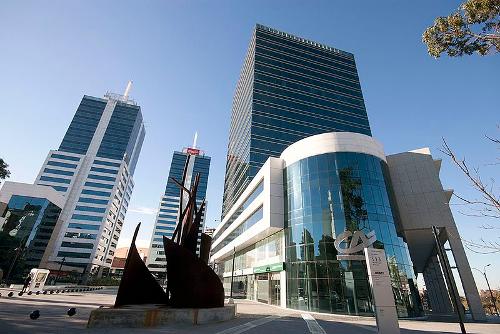 World Trade Center in Montevideo, UruguayPhoto: Marcelo Campi CC 2.0 Generic no changes made
World Trade Center in Montevideo, UruguayPhoto: Marcelo Campi CC 2.0 Generic no changes made
Mercosur (Mercado del Sur), the common economic market of Brazil, Argentina, Paraguay, Uruguay and Venezuela, was established in 1995. Bolivia, Chile, Peru, Ecuador and Colombia are associate members. Almost half of Uruguayan trade was with Mercosur members. The largest sector of the national economy is the tertiary sector, which includes restaurants, hotels, transport and communication. The banking system also generates a lot of income. It is organized in much the same way as in Switzerland, so with strict banking secrecy.
Agriculture, animal husbandry, fishing, forestry
Traditionally, Uruguay has been mainly a country of cattle and sheep. 9 million head of cattle and 21 million sheep graze there, especially in the center of the country. Due to lack of investment and low prices for wool, income from this sector stagnated. Meat processing has also been an important industrial activity for a long time. Of the total land area, 77% is used for livestock farming and 9.5% consists of agricultural land (together approx. 16 million hectares).
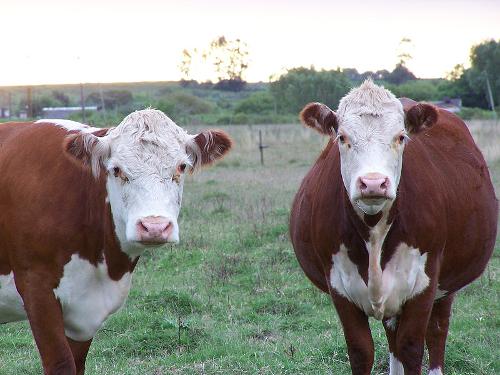 Hereford Cows, UruguayPhoto: Lux Valens CC 3.0 Unported no changes made
Hereford Cows, UruguayPhoto: Lux Valens CC 3.0 Unported no changes made
In the west and south, wheat, barley, soy, beans, onions, vegetables, fruit and grapes are grown. Big corporations dominate and strong mechanization over the years has led to high rural unemployment and strong migration to the city. Only in the southwestern coastal area does intensive agriculture occur, while more and more rice is grown around Lagoa Mirim. Wood is mainly imported from Brazil. Uruguay itself has a very limited forest cover (3.5% of Uruguay is covered with forest, 670,000 hectares of natural forest and 350,000 hectares of planted forest) that is largely used for firewood.
The National Fisheries Development Plan, carried out by the state fishing company INAPE, has proved a success. Sea fishing has grown rapidly since 1991 and the fish caught is frozen or exported as canned food. A lot of fish is caught every year, both in the lakes, the rivers and on the sea. The annual catch is still growing.
Mining and industry
All minerals found in Uruguay belong to the state. Of the proven minerals, only limestone is actually used for the cement industry; the extraction of the other minerals is impeded in part by transport difficulties. Marble and granite are mined on a modest scale. It also shows reserves of iron ore, gold and silver, copper, manganese, uranium and a type of brown coal.
Since Liebig started a meat extract factory in Frey Bentos in 1864, meat processing has been the basis of the industry in the country; slaughterhouses, cold stores and canning plants are mainly located in Paysandú, Montevideo and Frey Bentos.
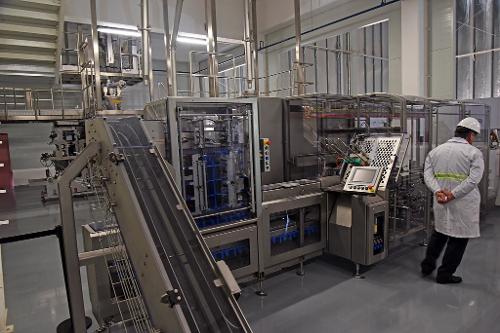 Industry, UruguayPhoto: MIEM, Uruguay (CC BY 2.0) no changes made
Industry, UruguayPhoto: MIEM, Uruguay (CC BY 2.0) no changes made
More than three quarters of all industry is located in or near Montevideo.
Improvement and expansion of existing and the establishment of new industries were stimulated, which has been of particular importance for the production of textiles, chemicals, electrical appliances and the metalworking industry. The industry also produces car tires, plastics, paint, cement, fertilizers, leather products (footwear), foodstuffs, glass, paper, dairy products and engines. The state oil refinery ANCAP in La Teja (near Montevideo) processes imported oil.
Energy
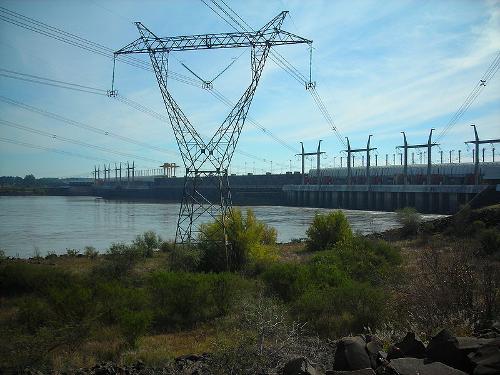 Salto Grande dam, UruguayPhoto: Lenilucho CC 3.0 Unported no changes made
Salto Grande dam, UruguayPhoto: Lenilucho CC 3.0 Unported no changes made
Until 1979, Uruguay was mainly dependent on thermal power plants that operated on increasingly expensive imported oil for its energy supply. Since July 1979, when the first turbines of the Argentine-Uruguayan Salto Grande joint project started operating, 73% of the installed capacity has been supplied by hydropower plants. The thermal power stations currently supply 27% of the required energy.
In collaboration with the El Palmar project (in the Río Negro) carried out by Brazil, Uruguay has even started exporting electricity. The electricity supply is in the hands of the state-owned Usinas y Transmisiones Eléctricas (UTE).
Trade
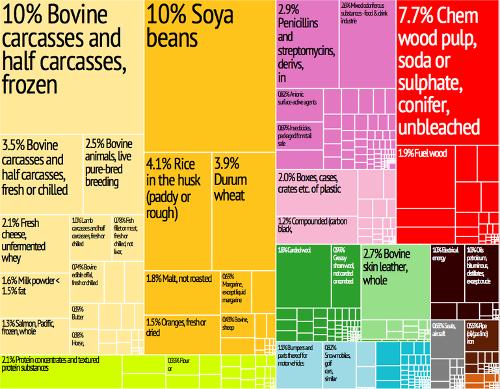 Export UruguayPhoto: R. Haussmann, Cesar Hidalgo, et.al CC 3.0 Unported no changes made
Export UruguayPhoto: R. Haussmann, Cesar Hidalgo, et.al CC 3.0 Unported no changes made
Wool and meat are still the main exports, followed by soybeans, hides and leather goods, textiles, fish and rice. In 2017, approximately $ 11.4 billion was exported mainly to the Mercosur countries, China, the countries of the European Union and the United States.
Oil plays an important role in imports; also imported means of transport, machines and foodstuffs. In 2017, $ 8.6 billion was imported from mainly China, the Mercosur countries, the countries of the European Union and the United States.
Traffic
There are almost 3000 km of railways in Uruguay. All railway lines converge in the capital, Montevideo. The railway network was built mainly with British capital in the last century and has played an important role in economic development, but is now very outdated. The rail network has been nationalized since 1948.
Domestic transport is largely done by road; the road network is quite dense at 60,000 km and connects the main cities and ports via a more than 20,000 km long system of asphalted highways. Two international bridges and a road across the Salto Grande dam connect Uruguay to Argentina. Four highways lead to Brazil. The “Southern Cone Axel Highway” connects Argentina, Brazil and Uruguay and runs from Porto Alegre in Brazil to Argentina's capital, Buenos Aires.
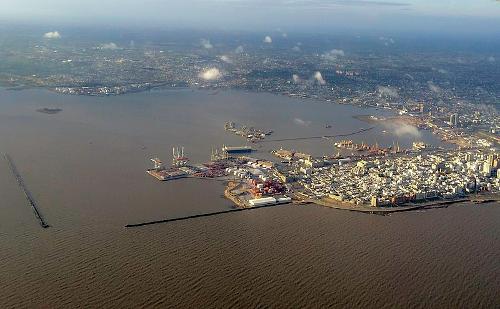 Port of Montevideo, UruguayPhoto: Jimmy Baikovicius CC2.0 Generic no changes made
Port of Montevideo, UruguayPhoto: Jimmy Baikovicius CC2.0 Generic no changes made
Uruguay's main ports are on the Atlantic Ocean, the Río de la Plata and Río Uruguay. Of great importance is the Río Uruguay, which is navigable to Paysandú for large sea-going vessels and allows shipping to the port of Salto, which is important for the export of the meat industry; over 95% of foreign trade is shipped in the port of Montevideo. Here too, the government is in control through the Administración Nacional de Puertos (A.N.P). Inland navigation has approx. 1200 km of navigable rivers and other waterways at its disposal. Uruguay is partnering with Argentina, Brazil, Bolivia and Paraguay in a project that aims to provide a reliable and efficient transportation system through rivers and canals.
The national airline PLUNA (Primeras Líneas Uruguayas de Navegación Aérea) maintains domestic air traffic and some scheduled services to neighboring countries. The national airport is Carrasco in the vicinity of Montevideo.
Sources
Bernhardson, W. / Argentina, Uruguay & Paraguay
Lonely Planet
Haitsma, M. / Uruguay: een landenmap
Novib
Jermyn, L. / Uruguay
Marshall Cavendish
CIA - World Factbook
BBC - Country Profiles
Copyright: Team The World of Info